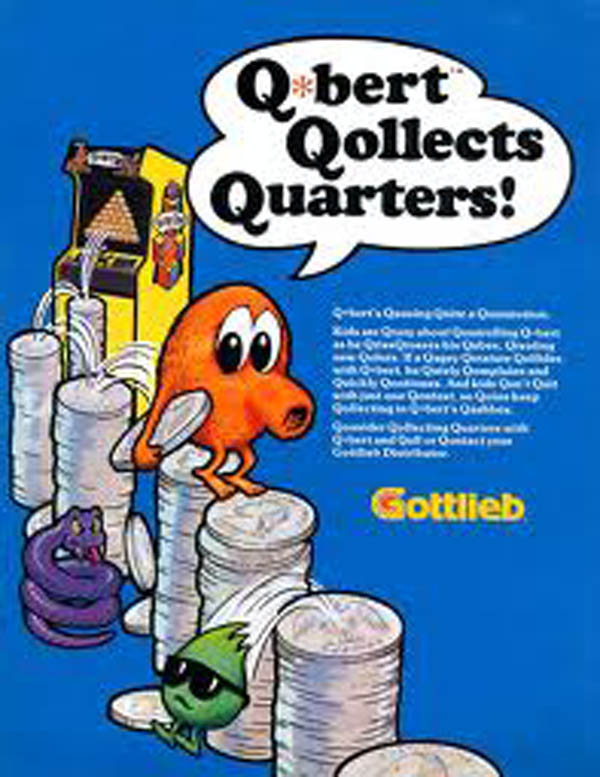

 |

|
 |
Q*bertQ*bert /ˈkjuːbərt/ is an arcade video game developed and published by Gottlieb in 1982. It is a platform game that features two-dimensional graphics. The object is to change the color of every cube in a pyramid by making the on-screen character jump on top of the cube while avoiding obstacles and enemies. Players use a joystick to control the character.The game was conceived by Warren Davis and Jeff Lee. Lee designed the titular character based on childhood influences and gave Q*bert a large nose that shoots projectiles. His original idea involved traversing a pyramid to shoot enemies, but Davis removed the shooting game mechanic to simplify gameplay. Q*bert was developed under the project name Cubes, but was briefly named Snots And Boogers and @!#?@! during development. Q*bert was well received in arcades and by critics, who praised the graphics, gameplay and main character. The success resulted in sequels and use of the character's likeness in merchandising, such as appearances on lunch boxes, toys, and an animated television show. The game has since been ported to numerous platforms. Developed during the period when Columbia Pictures owned Gottlieb, the rights to Q*bert stayed with Columbia even after they divested themselves of Gottlieb's assets in 1984 and therefore, is currently a property of Sony Pictures Entertainment who acquired Columbia in 1989. In 2012's Wreck-It Ralph, Q*bert's appearance is credited to "Columbia Pictures Industries, Inc." Q*bert GameplayQ*bert is an isometric platform game with puzzle elements where the player controls the titular protagonist from a third-person perspective. Q*bert starts each game at the top of an isometric pyramid of cubes, and moves by jumping diagonally from cube to cube. Landing on a cube causes it to change color, and changing every cube to the target color allows the player to progress to the next stage. In later stages, each cube must be hit multiple times to reach the target color. In addition, cubes will change color every time Q*bert lands on them, instead of remaining on the target color once they reach it. Jumping off the pyramid results in the character's death.The player is impeded by several enemies: Coily - A purple snake that chases after Q*bert. Ugg and Wrong-Way - Two purple creatures that run along the sides of the cubes Slick and Sam - Two green gremlins that revert the color changes that have occurred. A collision with purple enemies is fatal to the character. Colored balls occasionally appear at the top of the pyramid and bounce downward; contact with a red ball is lethal to Q*bert, while contact with a green one will immobilize the on-screen enemies. Upon dying, Q*bert emits a sound likened to swearing. A multi-colored disc on either side of the pyramid serves as an escape device from danger, particularly Coily. The disc returns Q*bert to the top of the pyramid, tricking Coily to jump off the pyramid if the snake was in close pursuit. This would cause all enemies and balls on the screen to disappear when Coily died. ReceptionQ*bert was Gottlieb's only video game that gathered huge critical and commercial success, selling around 25,000 arcade cabinets. Cabaret and cocktail versions of the game were later produced. The machines have since become collector's items; the rarest of them are the cocktail versions. Author Steve Kent and GameSpy's William Cassidy considered Q*bert one of the more memorable games of its time. Author David Ellis echoed similar statements, calling it a "classic favorite". 1UP.com's Jeremy Parish included Q*bert among the higher-profile classic games. In 2008, Guinness World Records ranked it behind 16 other arcade games in terms of their technical, creative and cultural impact. Video game critics focused on the gameplay and visuals. Kim Wild of Retro Gamer magazine described the game as difficult yet addictive. Author John Sellers also called Q*bert addictive, and praised the sound effects and three-dimensional appearance of the graphics. Computer and Video Games magazine praised the game's graphics and colors. Cassidy called the game unique and challenging; he attributed the challenge in part to the control scheme. IGN's Jeremy Dunham felt the controls were poorly designed, describing them as "unresponsive" and "a struggle". He commented that despite the controls, the game is addictive. William Brohaugh of Creative Computing Video & Arcade Games described the game as an "all-round winner" that had many strong points. He praised the variety of sound effects and the graphics, calling the colors vibrant. Brohaugh lauded Q*bert's inventiveness and appeal, stating that the objective was interesting and unique. The main character also received positive press coverage. Edge magazine attributed the success of the game to the title character. They stated that players could easily relate to Q*bert, particularly because he swore. Computer and Video Games, however, considered the swearing a negative, but still felt the character was appealing. Cassidy believed the game's appeal lay in the main character. He described Q*bert as cute and having a personality that made him stand out in comparison to other popular video game characters.
|
CAN'T FIND WHAT YOU'RE LOOKING FOR? CLICK HERE!!!